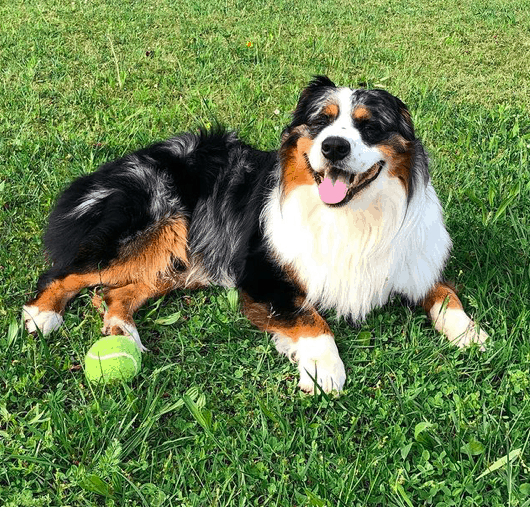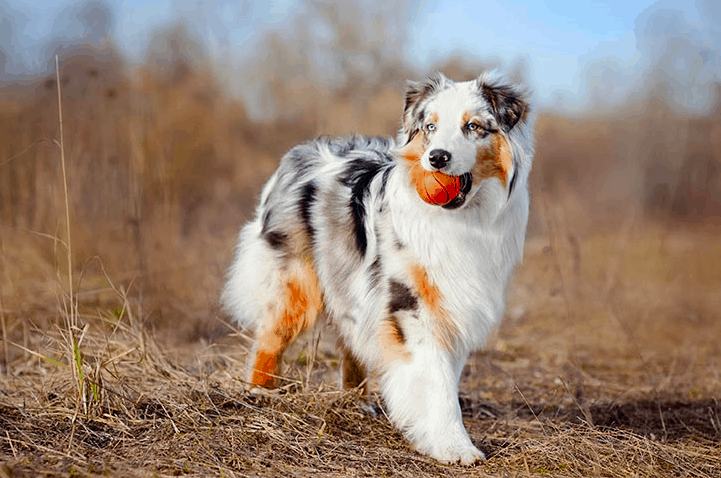Last Updated on September 28, 2024 by Dogs Vets
Do Australian Shepherds Like to Cuddle?
Australian Shepherds are known for their loyalty and intelligence, but when it comes to cuddling, they have a mind of their own. While many Aussies enjoy snuggling, they are independent and strong-willed, often deciding when they want affection.
So, don’t be surprised if your Aussie isn’t always in the mood for cuddles—they prefer it on their terms.

Overview of Australian Shepherds
| Breed Name | Australian Shepherd |
| Common Nicknames | Aussie |
| Origin | United States |
| Height | Male: 48–58 cm (19–23 in); Female: 46–56 cm (18–22 in) |
| Weight | Male: 18–32 kg (40–70 lb); Female: 16–29 kg (35–65 lb) |
| Coat | Straight, sometimes wavy, double-coated |
| Colors | Tri-color (black/red/blue), Bi-color (black/red/blue), Blue Merle, Red Merle |
| Litter Size | 5-10 puppies |
| Life Span | 12–14 years |
| Temperament | Intelligent, energetic, loyal, and affectionate; thrives on mental and physical activity |
| Exercise Needs | High; requires daily exercise and mental stimulation |
| Best For | Active families, individuals who enjoy outdoor activities, or those looking for a working/herding dog |
| Common Health Issues | Hip dysplasia, epilepsy, vision problems (especially in Merle-to-Merle breeding), deafness in some cases, especially in dogs with excessive white markings on the ears |
| Grooming Needs | Moderate; regular brushing to prevent matting, especially during shedding season |
| Price Range | $600 – $800 for a registered puppy |
| Popularity (US) | Ranked 17th most popular breed |
| Activities | Herding, agility, frisbee, obedience training, search and rescue, therapy work |
| Other Names | None specific, although many owners simply refer to them as “Aussies” |
History of the Australian Shepherd
Despite their name, Australian Shepherds originated in the United States during the 1840s, around the time of the Gold Rush. These dogs were bred for herding livestock and are still used as working dogs today. Their high energy and intelligence make them excellent companions for active families, but they also thrive when given a job to do, such as participating in dog sports or agility training.
Interestingly, while their exact origin before arriving in the U.S. is debated, the Australian Shepherd’s association with Australia is not rooted in their actual history.
Physical Characteristics: Size, Colors, and Coat
Australian Shepherds are medium-sized dogs with males typically weighing between 40–70 lbs (18–32 kg) and females weighing 35–65 lbs (16–29 kg). Males stand 19–23 inches (48–58 cm) tall, while females range from 18–22 inches (46–56 cm).
Coat and Colors
The Australian Shepherd’s coat is straight or slightly wavy, with recognized color variations such as:
- Solid black
- Solid red (liver)
- Blue merle
- Red merle
Many Australian Shepherds are tri-colored, featuring a combination of black/red, copper, and white markings, especially on the face, chest, and legs. Some Aussies are born with naturally bobbed tails, while others have long tails that are often docked in the U.S. and Canada. Docking is prohibited in many European countries.
Temperament and Behavior
Australian Shepherds are known for their energetic and work-focused nature. They thrive on mental and physical stimulation, making them excellent at sports like agility, Frisbee, and herding trials.

Despite their high energy, they can also be affectionate and devoted companions. Aussies are typically reserved with strangers but are very loyal and protective toward their families. While not prone to obsessive barking, they do have a strong guarding instinct, which makes them excellent watchdogs.
Health Concerns and Lifespan
Australian Shepherds are generally healthy, they are prone to certain health issues, including:
- Vision problems, such as cataracts and progressive retinal atrophy.
- Epilepsy, a common neurological disorder in the breed.
- Merle-to-merle breeding increases the risk of deafness and blindness.
On average, Australian Shepherds live between 12–14 years, but their lifespan can vary based on genetics and overall care.
Food and Diet
Proper nutrition is essential for maintaining the health and vitality of an Australian Shepherd. Look for puppy formulas that support brain development and vision health, such as those containing DHA and antioxidants.
Some recommended food brands for Australian Shepherd puppies include:
- Purina Puppy Food
- Purina One SmartBlend Healthy Puppy
- Purina Pro Plan FOCUS Puppy
Cost of Australian Shepherd Puppies
If you’re looking to buy an Australian Shepherd puppy, expect to pay between $600 and $800 from a registered breeder. Female puppies are generally slightly cheaper than males. Always consider adopting from shelters or rescues as an option.
Sports and Activities
Australian Shepherds excel in a wide range of canine sports, including:
- Agility
- Herding trials
- Frisbee
- Flyball
Their natural herding instincts make them great competitors in these sports, and they are also trained for search and rescue, therapy, and guide dog roles.
Rescue groups
Rescue groups play a vital role in finding homes for Australian Shepherds (Aussies) that need adoption or fostering. However, many potential adopters may not fully understand the responsibilities and challenges associated with owning this breed.
They love it, until they don’t.😂
These Australian Shepard dogs are incredibly smart and love to work. And a bit of a clown as well.🤣 pic.twitter.com/ZUlUyOOO7k
— floridanow1 (@floridanow1) April 27, 2024
Understanding the Commitment
Aussies require significant time, energy, and resources. They are high-energy dogs known for their intelligence and strong herding instincts. Prospective owners should be prepared for a commitment that includes regular exercise, mental stimulation, and training to prevent behavioral issues. Without proper guidance, an Aussie may assume a leadership role in the household, which can lead to stress and undesirable behaviors.
Key Considerations Before Adopting
- Temperament: Aussies are protective and can exhibit herding behaviors, such as nipping at heels, especially around children. Understanding their temperament is crucial to ensure a good fit with your lifestyle.
- Home Environment: Ensure your home is safe for an active dog. Consider potential hazards and whether your living situation can accommodate an Aussie’s needs.
- Financial Responsibility: Adoption fees often do not cover the full cost of care, which includes food, veterinary care, and training. Be prepared for ongoing expenses.
Finding a Rescue Group
If you are interested in adopting an Aussie but cannot find a local rescue group, consider reaching out to national or local breed clubs. They can provide resources and direct you to available Australian Shepherd rescues in your area.
Steps to Adoption
- Research: Understand the breed’s characteristics and requirements.
- Application: Complete an adoption application to help the rescue assess your suitability as an owner.
- Meet & Greet: Arrange a meeting with potential dogs to see if there is a good match.
- Home Check: Expect a home visit or virtual check to ensure a safe environment for the dog.
- Finalization: Once approved, you will complete adoption contracts and pay any fees.
By taking these steps and considering the responsibilities involved, you can provide a loving forever home to an Aussie in need.
FAQs
1. Are Australian Shepherds good family pets?
Yes, Australian Shepherds can be excellent family pets, especially for active households that can meet their exercise needs. They are loyal, protective, and highly trainable.
2. Do Australian Shepherds get along with other pets?
With proper socialization, Australian Shepherds can get along well with other pets. Their herding instincts may cause them to attempt to herd smaller animals, so supervision is important.
3. How much exercise does an Australian Shepherd need?
Australian Shepherds need a significant amount of exercise—at least 1–2 hours per day. This can include walks, runs, playtime, and mental stimulation like training or puzzle games.
4. Are Australian Shepherds easy to train?
Yes, Australian Shepherds are highly intelligent and eager to please, which makes them relatively easy to train. However, they do require consistent and positive reinforcement.
5. Do Australian Shepherds shed a lot?
Yes, Australian Shepherds have a double coat and shed year-round, with heavier shedding occurring during seasonal changes. Regular brushing can help manage their shedding.
Fact Check
We strive to provide the latest valuable information for pet lovers with accuracy and fairness. If you would like to add to this post or advertise with us, don’t hesitate reach us. If you see something that doesn’t look right, contact us!
Reference: Wikipedia,

















